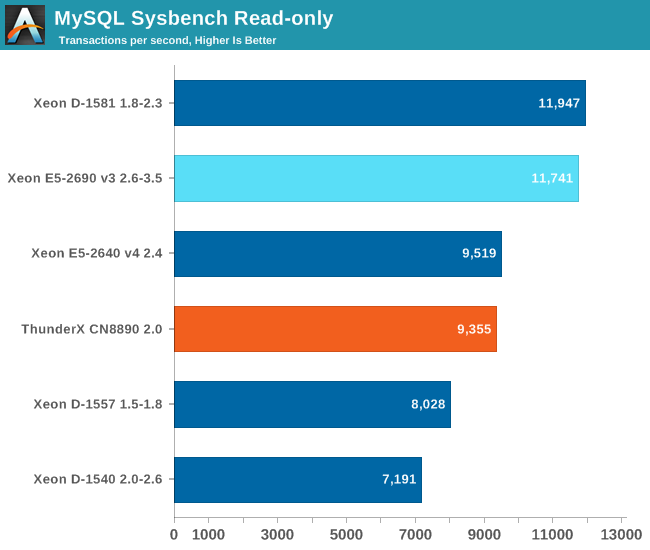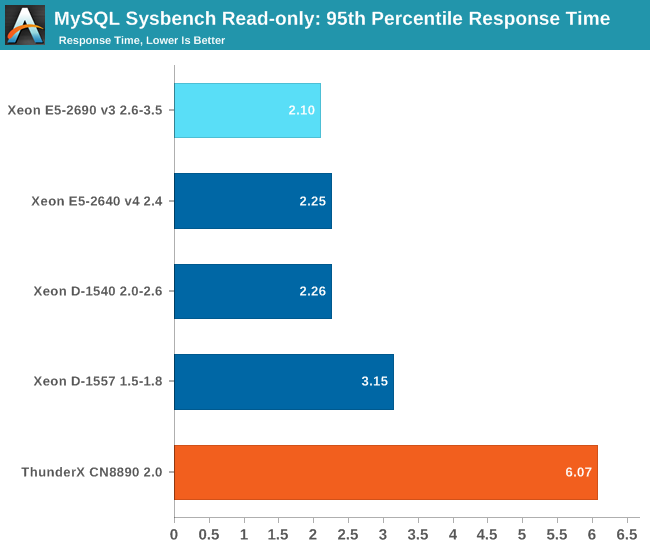Investigating Cavium's ThunderX: The First ARM Server SoC With Ambition
by Johan De Gelas on June 15, 2016 8:00 AM EST- Posted in
- SoCs
- IT Computing
- Enterprise
- Enterprise CPUs
- Microserver
- Cavium
MySQL 5.6.0
Last time we made a small error in our script, causing the Sysbench test to write to our SSDs anyway. That did not make the test invalid, but as we really want to isolate the CPU performance. However due to these changes, you cannot compare this with any similar Sysbench based benchmarking we have done before.
The Intel servers were running Percona Server 5.6 (the best-optimized MySQL server for x86), the ThunderX system was running a special ThunderX optimized version of MySQL 5.6. We used sysbench 0.5 (instead of 0.4) and we implemented the (lua) scripts that allow us to use multiple tables (8 in our case) instead of the default one. According to Cavium, there is still a lot headroom to improve MySQL performance. A ThunderX optimized version of Percona Server 5.7 should improved performance quite a bit.
For our testing we used the read-only OLTP benchmark, which is slightly less realistic, but a good first indication for MySQL Select performance.

A single ThunderX core is capable of 270 transactions/s and scales well: with 32 threads and one thread per core we still get about 8000 tr/s (or 250 tr/s/core). But beyond that point, scaling is much more worse: add another 16 cores and we only get 17% more performance.

But when we look at the response times, things look a lot less rosy. The ThunderX is a lot slower when handling the more heavy SQL statements.
It is clear that the ThunderX is no match for high frequency trading and other database intensive applications. However, when MySQL serves as just a backend for a website and satisfies simple "get data x or y" requests, the 4 extra ms are a small nuisance.










82 Comments
View All Comments
JohanAnandtech - Wednesday, June 15, 2016 - link
Good suggestion. I have been using an ipmi client to manage several other servers, like the IBM servers. However, such a GUI client is still a bit more userfriendly, ipmi commands can get complicated if you don't use them regularly. The thing is that HP and Intel's BMC GUI are a lot easier to use and more reliable.fanofanand - Wednesday, June 15, 2016 - link
I think you may have an inaccurate figure of 141 at idle (in the graph) for the Thunder. "makes us suspect that the chip is consuming between 40 and 50W at idle, as measured at the wall"JohanAnandtech - Wednesday, June 15, 2016 - link
If you look at the Column "peak vs idle", you see 82W. At peak, we assume that a 120W TDP chip will probably need about 130W. 130W - 82W (both measured at the wall) = 50W for the SoC alone at idle measured at the wall, so anywhere between 40-50W in reality. My Calculation is a "guestimate", but it is clear that the Cavium chip needs much more in idle than the Intel chips.(10-15W) .djayjp - Wednesday, June 15, 2016 - link
Many spelling/grammar issues here. It impacts readability. Please read before posting.djayjp - Wednesday, June 15, 2016 - link
That is to say in the article.mariush - Wednesday, June 15, 2016 - link
These guys are already working on ThunderX2 (54 cores, 3 Ghz , 14nm , ARMv8) and they already have functional chips : https://www.youtube.com/watch?v=ei9uVskwPNEMeteor2 - Thursday, June 16, 2016 - link
It's always jam tomorrow, isn't it? Intel is working on new chips too, you know.beginner99 - Wednesday, June 15, 2016 - link
It loses very clearly in performance/watt to Xeon-D. In this segment the lower price doesn't matter in that case and the fact that it has a process disadvantage doesn't matter either. What counts is the end result. And I doubt it would cost $800 if made on 14/16nm. I mean why would anyone buying this take the risk? Safer bet to go with Intel also due to more flexible use (single and multi threaded). The latency issue is mentioned but downplayed.blaktron - Wednesday, June 15, 2016 - link
So downplayed. Anandtech desperately wants ARM servers, but its a solution looking for a problem. Big web front ends running on bare metal are such a small percentage of the server market that developing for it seems stupid. Xeon-D was already in development for SANs, they just repurposed it for docker and nginx.Senti - Wednesday, June 15, 2016 - link
Very nice article. I especially liked the emphasis on relations of test numbers and real world workloads and what was problematic during the testing.It would be great to see the same style desktop CPU review (Zen?) form you instead of mix of reprinted marketing hype with silly benchmark numbers dump that plagues this site for quite some time now.
Some annoying typos here and there, like "It is clear that the ThunderX is a match for high frequency trading", but nothing really bad.